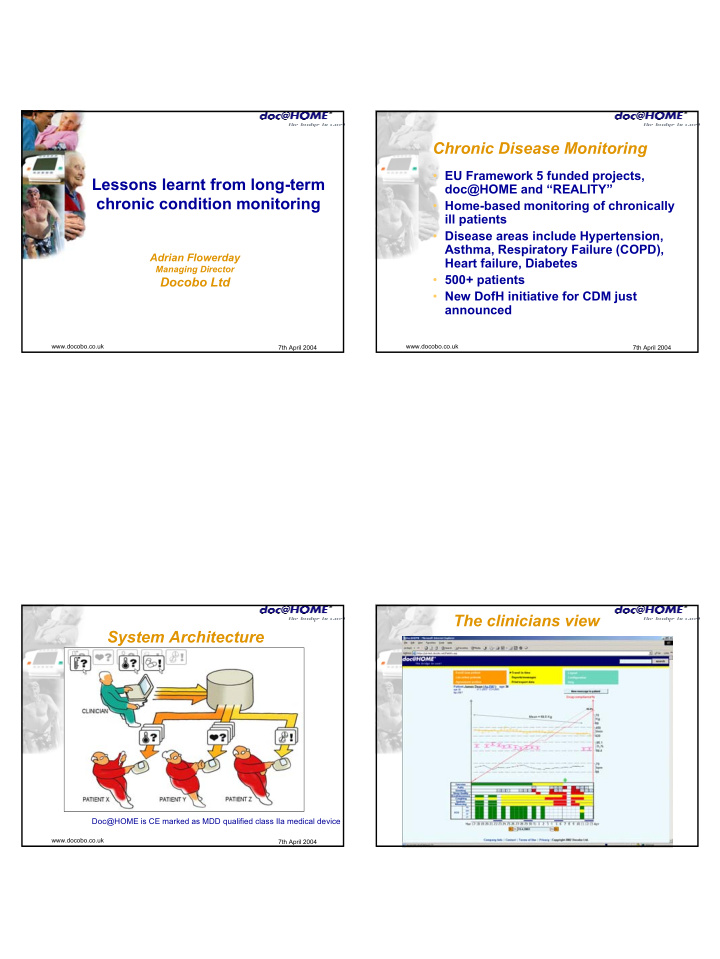



Chronic Disease Monitoring • EU Framework 5 funded projects, Lessons learnt from long-term doc@HOME and “REALITY” chronic condition monitoring • Home-based monitoring of chronically ill patients • Disease areas include Hypertension, Asthma, Respiratory Failure (COPD), Adrian Flowerday Heart failure, Diabetes Managing Director • 500+ patients Docobo Ltd • New DofH initiative for CDM just announced www.docobo.co.uk www.docobo.co.uk 7th April 2004 7th April 2004 The clinicians view System Architecture Doc@HOME is CE marked as MDD qualified class IIa medical device www.docobo.co.uk www.docobo.co.uk 7th April 2004 7th April 2004
Invasion vs value The need for invasion • Better monitoring, better management • Physiological + symptoms, side effects and quality of life • But how much invasion? - Impacts on routine - Too much becomes a burden - Leads to reduction of compliance www.docobo.co.uk www.docobo.co.uk 7th April 2004 7th April 2004 Interaction Compliance Disease specific benefits • Voluntary, patient initiated interaction; • mean lag days (days between successive interactions) • High resolution data collection used as a measure of compliance. • usage levels can be optimised by employing a user – A “sea of data” – searching for the benefits interaction refresh period of less than 3-months – design in – Trend detection; precise BP & real effects 20 6 Peak of summer holiday season of medication 30 10 5 • Medication compliance benefits 4 N Lag in days r – Compliance increased by >100% o 40 0 f L 0 5 10 15 a 3 g • Patient understanding and self control s Mean lag days 2 50 70 1 1.00 2.00 3.00 4.00 5.00 6.00 7.00 8.00 9.00 10.00 60 Months of participation www.docobo.co.uk www.docobo.co.uk 7th April 2004 7th April 2004
Compliance – BP Measurement #1 Compliance – BP Measurement #2 143.5 Morning 143.0 146 Conclusions Conclusions 142.5 Systolic Blood Pressure (mm/Hg) 142.0 144 •Blood pressure cycles correlated g • BP drop from Friday evening in rn o 141.5 with the period of clinician m st_ • BP increase from Monday re consultations (approx 3 months) i_ 141.0 142 Mean of bp_hi_rest_morning h _ p f b 140.5 • Drug compliance is low over the o •Patients are “nagged” when they n a e weekend M 140.0 140 see their consultant and this 1 2 3 4 5 6 7 143.5 Nädalapäev results in better drug compliance / • High risk caused by combination Evening lifestyle, which then tails off. of stress and lack of medication – 138 143.0 target intervention at high risk •Automated / semi-automated 142.5 points 136 “nagging” could improve the 1.00 2.00 3.00 4.00 5.00 6.00 7.00 8.00 9.00 10.00 11.00 12.00 g in 142.0 Months situation. n ve Osavõtt kuudes e i_ h _ p 141.5 f b o n a e M 141.0 1 2 3 4 5 6 7 Monday Tuesday Wednesday Thursday Friday Saturday Sunday Nädalapäev www.docobo.co.uk www.docobo.co.uk 7th April 2004 7th April 2004 Self Registered Compliance? The need for training • Self (voluntary) registration of anti- • The patient hypertensive medication - Needs to understand benefits compliance by patients. - the obvious • Very high correlation found - the long term between self-registered compliance • The healthcare professional and BP control. - Needs to understand benefits • Results suggest that self-registered - A new process compliance is a relatively reliable - New protocols measure. www.docobo.co.uk www.docobo.co.uk 7th April 2004 7th April 2004
In conclusion Barriers to entry • Better monitoring essential to control • Recognition of benefits in clinical community – lack of funding chronic disease • Commercial considerations • Level of invasion managed - Cost, reimbursment mechanisms, reliability • Standards to allow inter-operability • Regulatory considerations needed - MHRA/FDA - Data security • Lack of standards - TV industry model - Interoperability - Co-operation is key www.docobo.co.uk www.docobo.co.uk 7th April 2004 7th April 2004 Lessons learnt from long-term chronic condition monitoring Thank you! Adrian Flowerday Docobo Ltd www.docobo.co.uk 7th April 2004
Recommend
More recommend